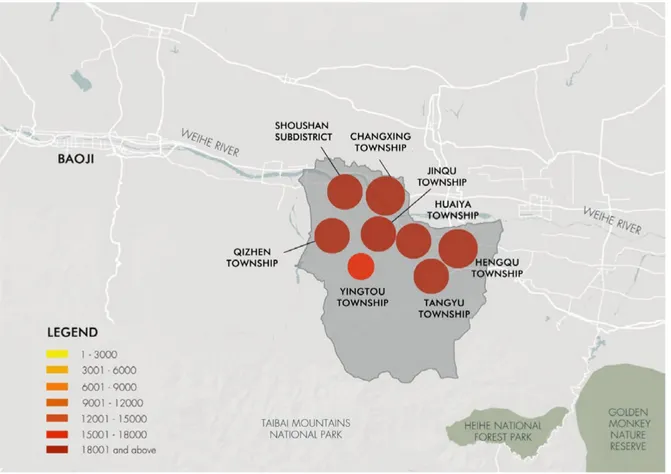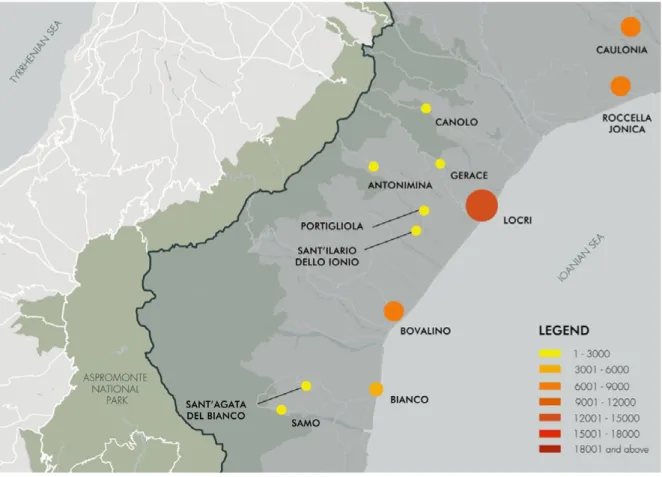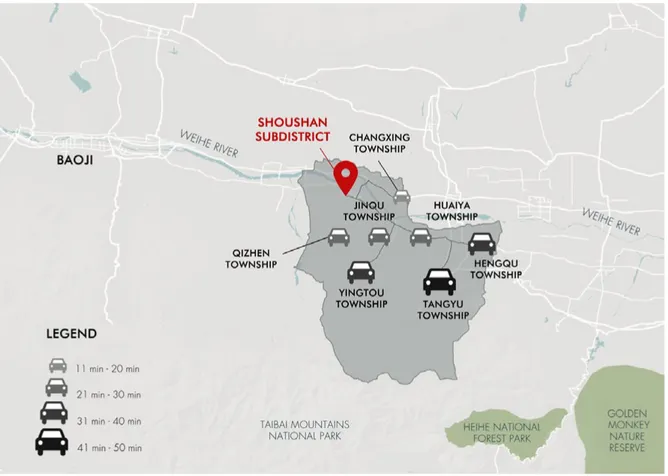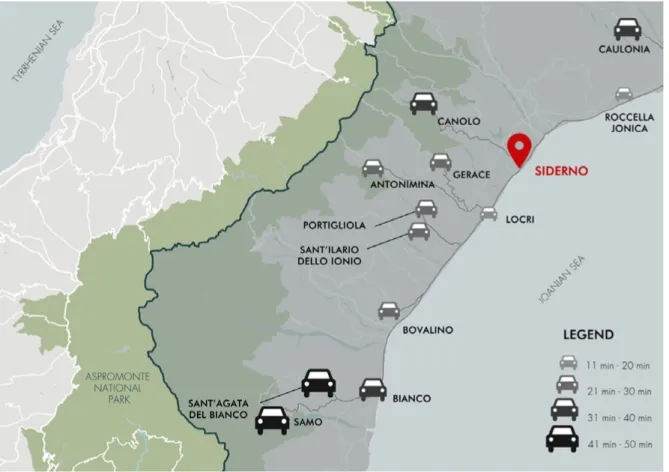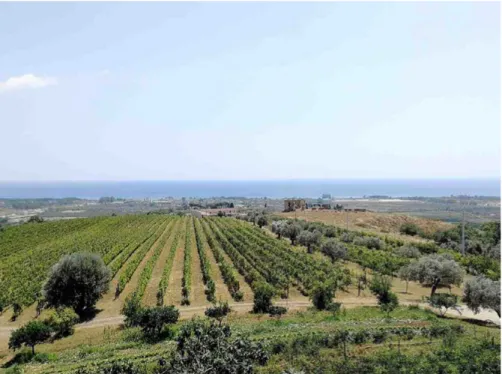ArcHistoR EXTRA 6 (2019)
www.archistor.unirc.it
La Mediterranea verso iL 2030
studi e ricerche sul patrimonio storico e sui paesaggi antropici, tra conservazione e rigenerazione
a cura di Marina Mistretta, Bruno Mussari, Adolfo Santini
t h e M e d i t e r r a n e a t o w a r d s 2 0 3 0 s t U d i e s a n d r e s e a r C h o n h i s t o r i C a L h e r i t a G e a n d a n t h r o P i C L a n d s C a P e s , C o n s e r vat i o n a n d r e G e n e r at i o n ISSN 2384-8898 ISBN 978-88-85479-08-1 Supplemento di ArcHistoR 12/2019
Yapeng ou, Carmelina Bevilacqua [email protected], [email protected]
Rigenerazione del paesaggio e economie di innovazione, i casi della contea di Meixian (Cina) e della locride (Italia)
Il paesaggio sta acquisendo un ruolo sempre più rilevante per lo sviluppo, come aggregazione di dinamiche economiche, socioculturali e ambientali. Tuttavia, le modalità secondo cui tale accezione di paesaggio può nella pratica tradursi in processi di costruzione di vantaggi competitivi, critici per lo sviluppo, non sono ancora chiare, rendendo la discussione degli argomenti correlati, nella letteratura esistente, sganciata dalle peculiarità dei processi di conoscenza per l’azione. Ciò è particolarmente evidente nelle zone rurali, dove il degrado del paesaggio e la debolezza del tessuto economico rappresentano problematiche ricorrenti. In tale contesto, l’approccio al paesaggio proposto ha l’obiettivo di coniugare e bilanciare, nello stesso tempo, lo sviluppo delle economie di innovazione e le pratiche di rigenerazione del paesaggio in modo da produrre un concorrente effetto positivo sullo sviluppo rurale e sui paesaggi rurali. I due casi studio, la contea di Meixian della provincia dello Shaanxi (Cina) e l’area della Locride della provincia di Reggio Calabria (Italia), pur nella diversità socio-culturale e politica, presentano similarità nelle traiettorie dello sviluppo rurale. L’analisi dei casi studio è proposta come approccio metodologico per impostare gli elementi costruttivi di azioni coordinate, capaci di disegnare e realizzare economie dell’innovazione attraverso meccanismi di rigenerazione del passeggio, anche nell’accezione delle connessioni urbano-rurali.
t h e M e d i t e r r a n e a t o w a r d s 2 0 3 0 s t U d i e s a n d r e s e a r C h o n h i s t o r i C a L h e r i t a G e a n d a n t h r o P i C L a n d s C a P e s , C o n s e r vat i o n a n d r e G e n e r at i o n
Economies, Cases from Meixian County (China) and
the Locride Area (Italy)
Yapeng ou, Carmelina Bevilacqua
As an aggregation of socioeconomic, cultural and environmental dynamics, rural landscape is commonly considered as relevant to rural development1. the various resources embedded in rural
landscape can be mobilized in many ways by rural actors to drive rural development2. its relevance
to public interest, socioeconomic and ecological services, cultural identity, well-being, quality of life, and economic development has also been highlighted by national and international instruments on landscape. however, rural landscape is changing by nature, being subject to the dynamics related to socioeconomic changes in land use3, population distribution and farming infrastructure.
Understanding these structural changes and their impacts on landscape and thereby managing them are vital for sustainable regional planning and development4. however, the concept that rural
landscape is relevant to rural development seems rather elusive. it is unclear how rural landscape 1. Kizos et alii 2010; Agnoletti 2014; Hart 2015.
2. Antrop 2000; Kizos et alii 2010. 3. Guarino et alii 2017.
can actually be turned into competitive advantages critical to the development process. Despite that a strong interlink between rural development and landscape management is recognized, these two domains have developed, both as research fields and policy sectors, largely independently5. the
physical aspect of rural landscapes remains the focus of landscape-based development strategies. Consequently, this has resulted in not living rural landscapes but rather their visual representations, generally referred to as “countryside” and the associated “picturesque”. This often manifests as created landscapes void of vitality and agrarian productivity but instead full of agrarian imagery6.
The authors maintain that rural development needs to incorporate regeneration mechanisms to maintain, update and improve the functionality of rural landscapes to meet new socioeconomic needs. Meanwhile, innovation economies shall be bolstered to gain essential competitive advantages. This is because they are critical to foster a circular, endogenous system able to synergize and coordinate socioeconomic development and landscape development in the long run. within the academia, there is an emerging innovative approach that combines regeneration and landscape approach for urban development. Wolch calls for urban landscape regeneration, recognizing that the need to retrofit, reuse and restore obsolete or degraded urban landscapes is fundamental to urban sustainability7. Chen argues that construction and regeneration are two dimensions within
the process of urban landscape evolution8. Construction is a relatively static dimension, highlighting
results, whereas regeneration is a relatively dynamic one, emphasizing processes. The authors argue that regeneration approach and landscape approach are readily adaptable to the rural context and applicable to rural development. This is because both regeneration and landscape suggest a system characterized by totality, interrelations and multidimensional dynamic processes, which is an essential commonality of the urban and the rural. Similar to urban landscapes, rural landscapes are complex systems subject to dynamic forces in the economic, sociocultural and environmental spheres that have shaped and still keep shaping them9. as a system that embodies territoriality and
a space-time continuum, rural landscapes are the context where rural development issues can be properly understood and then tackled systematically. Within the system of rural landscapes, it needs
5. Rega 2014. 6. Roncken 2006. 7. Wolch 2013. 8. Chen 2013.
to be recognized that any social setting is nested in environmental, political and economic contexts, which affect the final success of any development strategy10.
This paper therefore proposes an experimental approach that conceptualizes and manages rural development according to an improved Landscape approach (iLa). the approach is based on the correlation between innovation economies and landscape regeneration. The research, based on literature review, adopts a qualitative approach with explanatory comparative analysis of case studies. It first constructs an improved landscape approach, expounding its components, i.e. landscape regeneration and innovation economies. Then, it tests the approach with case studies from Meixian County of Shaanxi Province (China) and the Locride area of Calabria Region (Italy) which show similar development trajectories despite their different socio-cultural and political contexts. Finally, it draws a brief conclusion and offers suggestions for future research.
Improved Landscape Approach (ILA)
The landscape approach first arose in the field of protected areas conservation which incorporated an ecosystem and landscape-scale thinking11. However, “people” and “society” and their impacts on
landscapes were excluded from related discussions12. then with increasing social concerns about
the trade-offs between environment and development, the concept deals with any spatially explicit attempt to address conservation and development objectives13. this broadened landscape approach
is, however, still largely associated with the management of places rich in natural resources. Beyond the natural conservation field, it is urban areas that have seen the experimentation of a landscape approach to urban development, with a broadened conceptualization of “landscape”. Urban landscapes are considered as a contributing factor to sustainable urban development14. the key
elements of urban landscapes are considered as «social, cultural and economic asset», and «sources of social cohesion, factors of diversity and drivers of creativity, innovation and urban regeneration»15.
10. Gobattoni et alii 2015. 11. Sayer et alii 2013. 12. Lawrence 2010. 13. Sayer et alii 2013. 14. Wu 2009; Salem 2016. 15. UnesCo 2013, p. 5.
Such a landscape approach is essentially a “landscape-based” one: the contribution of landscape to economic development is the major focus, while how landscape development can be sustainable is barely taken into consideration.
The authors propose an ILA conceived in a systemic way. It focuses on a holistic landscape consisting of natural ecological, sociocultural and built/agricultural landscapes. ILA seeks a harmonious integration of social, economic and environmental factors in space and time16. Integration means
that during rural development process, environmental and sociocultural processes are to be integrated into the economic development process. ILA not only recognizes the role of landscapes in development, but addresses the development-conservation trade-off. Emphasizing that landscapes are constantly changing, it tries to coordinate and balance landscape development and socioeconomic development. It is expected to achieve simultaneously: 1) “a sustainable landscape” evolution rather than landscape mutation both in terms of physical landscape and the embedded sociocultural landscape, and 2) “a sustainable socioeconomic development” that coordinates environmental, sociocultural and economic development. To this end, landscape regeneration and innovation economies are central to ILA.
Landscape regeneration is a process of adaptive adjustments of the sociocultural, economic and environmental fabrics of landscapes during landscape development. It is therefore a pivotal tool to mitigate negative sociocultural and environmental externalities resulting from rural transformations. As an adaptive activity, it is by nature holistic (system), incremental (process) and contextualized (place). as a means to coordinate and integrate the sociocultural, environmental and economic dynamics into the rural development process, it should focus both on the (improvement of the) physicality of rural landscapes and more importantly, the development of their core, that is, people, society and economy.
“Innovation economies” are defined as innovative economic activities characterized by product, process, market, and organizational innovations. In the era of knowledge economy, they are critical to rural development by boosting the comparative advantages of rural localities. To spur innovation economies in rural areas, related policy and strategy making must highlight 1) place-based approach; 2) networks; 3) sociocultural landscape regeneration; 4) an improved and proactive governance; 5) value-adding of rural landscapes; 6) agricultural innovation; 7) balance between economic specialization and diversification; and 8) multifunctionality of rural landscapes.
Landscape regeneration and innovation economies are fundamental for achieving ILA’s ultimate goal: improve the rural population’s quality of life. Therefore, ILA needs to adapt the physical landscape, sociocultural and economic structures and environmental system to changing production and living patterns during rural development. In so doing, ILA is conducive to two outcomes. First, it can continuously improve the quality of life of all people, in terms of not only economic benefits and opportunities, but living environment and sociocultural life. Second, more importantly, it is expected to foster the development process of endogenous, circular innovation systems to meet their multilevel needs and respond to ever-changing socioeconomic environment rather than generating merely the result of renovation.
Case Studies
The cases analyzed are the Lotus Park and its extension Lotus Town project in Meixian County and the regeneration of Maremonte in Locride.
among the socioeconomic indicators used to compare the two areas where the case studies are located, the figures below show the population density (figg. 1-2) and the time traveling (figg. 3-4) as a “measure” of their urban system.
Lotus Park and Lotus Town are located in Hedi Village, about 5 km west of Meixian County. The sites used to be barren wastelands and deserted floodplain with poor vegetation and abandoned ponds (fig. 5). Maremonte, one of the oldest Condojanni and Sant’Ilario vineyards, olive groves and sheep farming areas, remained completely abandoned for years. In the following, their regeneration process and innovation economies are compared and discussed, focusing on the actors, principles, strategies, financing tools, and economic activities.
- “Actors”: Lotus Park and Lotus Town projects were “top-down” initiatives. They were respectively planned by the municipality of Meixian County and the Villagers’ Committee of Hedi Village (thereafter referred to as VC). While the construction of the former involved the collaboration between the county government, Jinqu Township, and VC, the latter was planned and implemented by VC. The regeneration of Maremonte, instead, was private-led: the property was purchased by a Canadian entrepreneur, who then established the winery and agritourism company “Casale li Monaci” on the site.
- “Principles”: Lotus Park, as an ecological restoration project, respected the principle of minimum intervention and made full use of the original ecological environment. The regenerated lotus
Figure 3. Travel time by car to the nearest urban pole Shoushan Subdistrict in Meixian County (Y. Ou based on Google Maps, 2018).
landscape shows traditional landscaping and reinterprets traditional values that highlight the importance of human-nature and human-society harmony. Similar practices were observed also at Maremonte. The vineyards, olive groves, and citrus orchards have been completely regenerated (fig. 6). To preserve the area’s historical significance and make it more climate resilient, mainly endemic varieties were planted. Remains of historic constructions were preserved. In terms of landscaping, new constructions respected the overall landscape, especially the Jonian Sea and surrounding hillsides. The traditional “casale” (a type of farmhouse typical to Calabria) was also reconstructed, a key element in traditional agricultural landscape in Calabria.
- “Strategies”: Landscape multifunctionality-based reuse is a common strategy. Both cases reclaimed wastelands or abandoned lands. They also integrated functions of ecological services (water Figure 5. Abandoned lotus ponds near Hedi Village (photo of Y. Ou, 2018).
ecology improvement, natural habitat, soil erosion prevention), sightseeing, recreation and didactic (fig. 7). Maremonte also recovered its function of agricultural production. Incrementalism is another strategy, especially in Meixian County’s case. Lotus Town as an extension of Lotus Park demonstrates an incrementalist strategy not only because the former is a complement of the latter which has limited capacity to fully perform its touristic functions (e.g. no catering or entertainment facilities). It is also because, more importantly, first, the initial funds were only enough to construct the park. Second, there was the tactic idea to use the park as a “test”: if it were to attract a considerable number of tourists and gain persistent popularity, building a recreational area would make more sense to harness and siphon off heavy tourist flows during peak seasons. Third, the aim of the first two years of operation was not profit-oriented, but rather to increase visibility and build up positive “word of mouth”.
Figure 7. sightseeing in the Lotus Park in hedi village (Y. ou, 2018).
- “Financing Tools”: While Lotus Park was financed by the municipality through transfer payment, Lotus Town saw the utilization of more creative financing tools. First, the lands where the project was implemented belong to two villagers’ groups, and were converted into shares of both. Second, funds were raised by integrating public funds under the “Collective Economy Program”, the collective’s own funds, and mortgage loans. The project did not involve any private investments, so as to decide its own “economic fate”. Third, at the initial stage, uncertain if the project would promise a success, no farmer invested personal savings in the project. However, to help alleviate poverty, 10 poor households, guaranteed by the villagers’ committee, were enabled to take loans from the local Credit Cooperative under its poverty alleviation program. Each of the 10 households holds one share, for which they can take a fixed annual dividend and a secondary dividend based on turnover.
- “Economic Activities”: Innovation economies in Hedi Village are typical collective economies with corporate management. The VC established “Meixian Lotus Park Tourism Development Co., Ltd.” to facilitate project implementation, site management, and tourism development. Tourism development has followed the “company + collective + farmers” pattern. To alleviate poverty, jobs related to management were assigned to vulnerable villagers. The VC also issued incentives to stimulate the involvement of local people. Part of the net profits are to be pooled into the fund owned by the collective for the site management, environmental and infrastructural improvement, and other collective investments. In the Maremonte case, “Casale li Monaci” adds value to its products and the regenerated agricultural landscape by extending its industrial chain. Currently, its operation covers all the three industrial sectors, from cultivation and livestock farming to processing, and finally agritourism which uses its own produces and products. its tourism development is marked by a diversification strategy to satisfy different tourist needs, offering recreation, cultural events, fitness, experience, gastronomy, didactic and other tailored services.
Conclusions
All in all, ILA is expected to help achieve sustainable rural development (social, economic and environmental) while promoting the contemporization of rural landscapes by mitigating negative externalities. Its ultimate goal is to improve the rural population’s quality of life. It therefore attempts to achieve simultaneously two goals. First, at the landscape level, it aims to manage rural landscape changes through regenerating natural, built/agricultural, and sociocultural landscapes. Second, at the economic level, it tries to spur innovation economies to strengthen competitive advantages and reduce the tension between environmental protection and economic growth.
The two cases are good examples of how regenerated landscapes can contribute to local development by generating not only environmental and sociocultural benefits, but conditions for developing innovation economies. The case studies reveal that first, ILA contributes to integrated rural development by generating multilevel benefits. Second, landscape regeneration and innovation economies are mutually reinforcing. While the former provides the physical and sociocultural conditions for the latter, the latter is critical to build up a community-based “material basis” supportive of the regeneration process. Third, they also reveal the need for an improved governance that follows a mixed form of centralized (top-down) and participatory (bottom-up) decision-making. This is crucial for more effective rural landscape regeneration and the development of innovation economies. Fourth,
collective economies are a viable medium to foster the development process of endogenous, circular innovation systems. This is rarely the case in Locride as private-led innovation is dominant, while local communities are excluded from the innovation process. The two cases also show one common limitation: networking and partnerships should have been established in regard of knowledge sharing and generation. The cases from Meixian County also demonstrate that creative fund-raising tools have been critical to develop collective economies. In addition, the incrementalist approach has proved quite commendable given the financial constraint and also potential project failure.
A further lens of investigation inherent in the case studies proposed lies in land reform and public-private partnerships issues. These aspects have been considered as another source of comparative discussions of rural landscape management and development strategies.
Bibliography
Agnoletti 2014 - M. Agnoletti, Rural landscape, nature conservation and culture: some notes on research trends and
management approaches from a (southern) European perspective, in «Landscape and Urban Planning», 2014, 126, pp.
66-73.
Antrop 2000 - M. Antrop, Background concepts for integrated landscape analysis, in «Agriculture, Ecosystems and Environment», 2000, 77, pp. 17-28.
Chen 2013 - Y. Chen, Urban Landscape Regeneration Theory and Method (in Chinese), southeast University Press, nanjing 2013.
Fujihara, Hara, Short 2005 - M. Fujihara, K. Hara, K.M. Short, Changes in landscape structure of “Yatsu” valleys: a typical
Japanese urban fringe landscape, in «Landscape and Urban Planning», 2005, 70, pp. 261-270.
Gobattoni et alii 2015 - F. Gobattoni et alii, Sustainable rural development: the role of traditional activities in central Italy, in «Land Use Policy», 2015, 48, pp. 412-427.
Guarino et alii 2017 - R. Guarino et alii, Disintegration of Italian rural landscapes to international environmental
agreements, in «International Environmental Agreements: Politics, Law and Economics», 2017, 17/2, pp. 161-172, doi:
10.1007/s10784-015-9310-9.
Hart 2015 - A.K. Hart, Multi-functional landscapes from the grassroots? The role of rural producer movements, in «Agriculture and Human Values», 2015, vol. 33, 2, pp. 1-18, doi: 10.1007/s10460-015-9611-1.
Kizos et alii 2010 - T. Kizos et alii , Introduction: landscape change and rural development, in «Landscape Research», 2010, vol. 35, 6, pp. 571-576, doi: 10.1080/01426397.2010.502749.
Lawrence 2010 - A. Lawrence (ed.), Taking Stock of Nature, Cambridge University Press, Cambridge UK 2010.
Rega 2014 - C. Rega, Introduction: rural development and landscape planning—key concepts and issues at stake, in C. Rega (ed.) Landscape Planning and Rural Development, Springer Briefs in Geography 2014, pp. 1-12, doi: 10.1007/978-3-319-05759-0_1.
Roncken 2006 - P.A. Roncken, Rural landscape anatomy: Public space and civil yards in Dutch rural landscapes of the
future, in «Journal of Landscape Architecture», 2006, 1/1, pp. 8-21, doi: 10.1080/18626033.2006.9723360.
Salem 2016 - D. Salem, Visions for urban landscape sustainability, past, present and future, in «European Journal of Sustainable Development», 2016, 5/3, pp. 419-432, doi: 10.14207/ejsd.2016.v5n3p419.
Sayer, Cassman 2013 - J. Sayer, K.G. Cassman, Agricultural innovation to protect the environment, in «PNAS», 2013, 110/21, pp. 8345-8348.
UNESCO 2013 - UNESCO, New Life for Historic Cities: The Historic Urban Landscape Approach Explained, UnesCo, Paris 2013.
Winchell, Koster 2010 - Winchell, R. Koster, Introduction: the dynamics of rural change: a multinational approach, in D.G. Winchell et alii (eds.), Geographical Perspectives on Sustainable Rural Change, Rural Development Institute, Brandon 2010, pp.1-40.
Wolch 2013 - Wolch J., Celebrating 100 Years of Landscape at Berkeley, 2013, https://frameworks.ced.berkeley. edu/2013/100-years/ (accessed on August 6, 2019).
Wu 2010 - J. Wu, Urban sustainability: an inevitable goal of landscape research, in «Landscape Ecology», 2010, 25, pp. 1-4, doi: 10.1007/s10980-009-9444-7.
